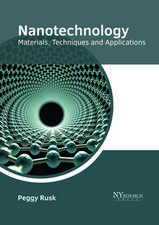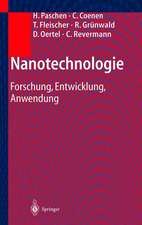Green's Function Integral Equation Methods in Nano-Optics
Autor Thomas M. Søndergaarden Limba Engleză Hardback – 28 ian 2019
Each presented method is accompanied by examples from nano-optics, including: resonant metal nano-particles placed in a homogeneous medium or on a surface or waveguide; a microstructured gradient-index-lens; the Purcell effect for an emitter in a photonic crystal; the excitation of surface plasmon polaritons by second-harmonic generation in a polymer fiber placed on a thin metal film; and anti-reflective, broadband absorbing or resonant surface microstructures. Each presented method is also accompanied by guidelines for software implementation and exercises.
Features
- Comprehensive introduction to Green’s function integral equation methods for scattering problems in the field of nano-optics
- Detailed explanation of how to discretize and solve integral equations using simple and higher-order finite-element approaches
- Solution strategies for large structures
- Guidelines for software implementation and exercises
- Broad selection of examples of scattering problems in nano-optics
| Toate formatele și edițiile | Preț | Express |
|---|---|---|
| Paperback (1) | 339.56 lei 43-57 zile | |
| CRC Press – 2 oct 2023 | 339.56 lei 43-57 zile | |
| Hardback (1) | 1119.13 lei 43-57 zile | |
| CRC Press – 28 ian 2019 | 1119.13 lei 43-57 zile |
Preț: 1119.13 lei
Preț vechi: 1364.79 lei
-18% Nou
Puncte Express: 1679
Preț estimativ în valută:
214.21€ • 232.76$ • 180.06£
214.21€ • 232.76$ • 180.06£
Carte tipărită la comandă
Livrare economică 21 aprilie-05 mai
Preluare comenzi: 021 569.72.76
Specificații
ISBN-13: 9780815365969
ISBN-10: 0815365969
Pagini: 430
Ilustrații: 14 Tables, black and white; 205 Illustrations, black and white
Dimensiuni: 156 x 234 x 28 mm
Greutate: 0.74 kg
Ediția:1
Editura: CRC Press
Colecția CRC Press
Locul publicării:Boca Raton, United States
ISBN-10: 0815365969
Pagini: 430
Ilustrații: 14 Tables, black and white; 205 Illustrations, black and white
Dimensiuni: 156 x 234 x 28 mm
Greutate: 0.74 kg
Ediția:1
Editura: CRC Press
Colecția CRC Press
Locul publicării:Boca Raton, United States
Public țintă
Academic and Professional Practice & DevelopmentCuprins
Introduction. Theoretical Foundation. One-dimensional Scattering Problems. Surface Integral Equation Method for 2D Scattering Problems. Area Integral Equation Method for 2D Scattering Problems. Volume Integral Equation Method for 3D Scattering Problems. Volume Integral Equation Method for Cylindrically Symmetric Structures. Surface Integral Equation Method for 3D scattering Problems. Chapter A: Residue Theorem. Chapter B: Conjugate Gradient Algorithm. Chapter C: Generalized Minimum Residual Algorithm. Chapter D: Bessel Functions. Chapter E: Analytic Scattering from a Cylinder and a Sphere. Chapter F: Calculating Guided Modes of Planar Waveguides. References.
Notă biografică
Dr. Thomas Søndergaard is currently an Associate Professor in Nano Optics, Aalborg University, Denmark. His areas of expertise include numerical methods for theoretical analysis of electromagnetic fields in micro- and nanostructures. Plasmonics: waveguiding, optical antennas, resonators and sensors based on a type of electromagnetic surface wave at metal-dielectric interfaces known as Surface Plasmon Polaritons. Photonic crystals: wavelength-scale periodic structures in which light with certain wavelengths cannot propagate, similar to electrons with certain energies not being able to progagate in semiconductors, and how this can be exploited for e.g. designing optical waveguides and cavities. Green’s function integral equation methods. Dr. Sondergaard has been awarded The Danish Independent Research Councils' Young Researcher's Award (2006) and The Danish Optical Society Award (2008). He is a board member of the Danish Optical Society and reviewer of 15-20 papers per year for such journals as Physical Review B, Physical Review Letters, Applied Physics Letters, Optics Express, IEEE Journal of Quantum Electronics, IEEE Journal of Lightwave Technology, Optics Communications, Physica status solidi (b), Nature Photonics, Optics Letters, and Journal of the Optical Society of America A/B. Dr. Sondergaard has also been published 84 papers in peerreviewed journals and holds three patents.
Descriere
This gives an introduction to using Green's function integral equation methods (GFIEMs) for solving scattering problems in nano-optics. The book covers types of integral equation methods for 1D, 2D, and 3D scattering problems in nano-optics, how the integral equations can be discretized and solved numerically, and how this can be done efficiently.





















